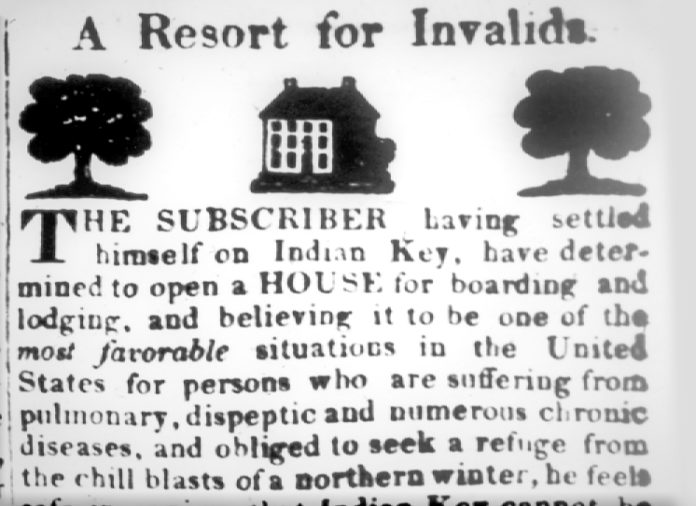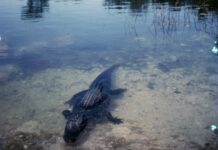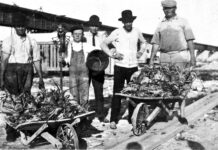The American period begins with the Adams-Onis Treaty that transferred the Florida Territory from Spanish ownership in 1821. Indian Key is a small 11-acre island in the Upper Keys surrounded by the Atlantic shallows about one mile offshore of Lower Matecumbe Key. Key Vaca is the island at the heart of Marathon, and Port Monroe was one of its earliest communities. During the American period, the history of Indian Key starts at the small Key Vaca outpost of Port Monroe.
Joshua Appleby and Captain John Fiveash established Port Monroe circa 1822. A handful of families lived at the outpost, including Silas Fletcher, his wife and two children. Appleby would partner with a man named Solomon Snyder to establish a general store on Indian Key. They hired Fletcher to build and operate it, and, in 1824, they packed a schooner with building supplies, and Fletcher sailed north.
Indian Key had advantages over the Port Monroe location. First, it was located more favorably along the Florida Reef and farther from the superior harbor and stores at Key West. Indian Key, too, had a convenient approach from Hawk’s Channel and a relatively deep natural harbor, which is not a common feature in the Florida Keys. Whether Appleby and Snyder realized it or not, Indian Key also had something going for it that not every island in the chain can claim. Because its position is just far enough offshore of the Matecumbe keys, the Atlantic breezes work to keep Indian Key relatively mosquito-free.
Fletcher hired Joseph Prince to accompany him to Indian Key. The two arrived in April 1824 and constructed the island’s general store, its first business. They also built a two-story structure to house Fletcher, his wife Avis, and their children, William and Abigail. Fletcher is considered Indian Key’s first permanent settler in the American period. It seems fitting that his family and Prince should be lumped into that category as well.
Fletcher and Prince would have an interesting history, as would the two-story house they built for Silas and his family. In January 1825, Fletcher and Prince made a pact, joined forces, bought out the financial interests of Appleby and Snyder, and became formal partners, buying “the store belonging to Snyder and Appleby, and all their interest and claim in and to Indian Key.” The Fletcher and Prince partnership would prove short-lived. Five months into their arrangement, Prince sold his interest in the general store, making Fletcher the sole proprietor. Prince, having dissolved his partnership, packed up and moved to Massachusetts. He would return several months later to open a second, competing general store on the island.
On Nov. 13, 1828, Silas Fletcher sold his general store, a two-story house, kitchen, and outhouse and his rights and claims to Indian Key for $2,500, to Thomas Gibson of Staten Island, New York. Gibson did not move to the island until 1830. Gibson would improve his properties, and by the time he sold his holdings and interests to his brother-in-law Jacob Housman several years later, the price had doubled. The July 5, 1831, transaction included a one-story store, two-story house, nine-pin bowling alley, billiards room and table, outhouse, and kitchen. The price was $5,000.
Fletcher’s former two-story home began operating as one of the Florida Keys’ earliest hotels and the first outside of Key West. Samuel Spencer was hired to run the operation and, by 1835, he was considered the proprietor of the hotel. The following advertisement for the Tropical Hotel was printed in the St. Augustine Herald, Charleston Courier, Philadelphia Saturday Courier, and New York Advocate and dated Indian Key, Monroe County, Territory of Florida, Nov. 7, 1835:
“The subscriber having settled himself on Indian Key, have determined to open a House for boarding and lodging, and believing it to be one of the most favorable situations in the United States for persons who are suffering from pulmonary, dyspeptic and numerous chronic diseases, and obliged to seek refuge from the chill blasts of a northern winter, he feels safe in saying that Indian Key cannot be surpassed for beauty, health and climate. Frost has never been known here — the thermometer seldom below 55 or 56 in winter, nor up to 90 in summer. It is entirely exposed to the sea from every point of the compass. The fare of his table and bar shall be as good as the market will afford, and attended by experienced servers. Private rooms for lodging gentlemen, ladies, and families neatly arranged. The undersigned hopes by diligent attention and industry to merit the custom of his friends and the public generally. S. A. Spencer (proprietor).”
Though he would continue to manage the hotel until the Aug 7, 1840, Indian attack, records indicate Spencer sold his interest in the hotel to Key West’s Pardon C. Greene and Fielding A. Browne in 1838.


























